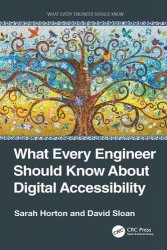What Every Engineer Should Know About Digital Accessibility
- Добавил: literator
- Дата: 25-03-2024, 22:56
- Комментариев: 0
 Название: What Every Engineer Should Know About Digital Accessibility
Название: What Every Engineer Should Know About Digital AccessibilityАвтор: Sarah Horton, David Sloan
Издательство: CRC Press
Серия: What Every Engineer Should Know
Год: 2024
Страниц: 269
Язык: английский
Формат: pdf (true)
Размер: 10.1 MB
Accessibility is a core quality of digital products to be deliberately addressed throughout the development lifecycle. What Every Engineer Should Know About Digital Accessibility will prepare readers to integrate digital accessibility into their engineering practices. Readers will learn how to accurately frame accessibility as an engineering challenge so they are able to address the correct problems in the correct way.
Illustrated with diverse perspectives from accessibility practitioners and advocates, this book describes how people with disabilities use technology, the nature of accessibility barriers in the digital world, and the role of engineers in breaking down those barriers. Accessibility competence for current, emerging, and future technologies is addressed through a combination of guiding principles, core attributes and requirements, and accessibility‑informed engineering practices.
This book spans a range of topics related to computer science, including software engineering, human–computer interaction, web and mobile application development, and product and project management. This is intentional. Accessibility considerations apply regardless of the role you might perform in a digital product development. Everyone has an opportunity to make informed decisions that help ensure that accessibility is a priority.
The Web Content Accessibility Guidelines (WCAG) provide us with a well‑established and robust set of core accessibility requirements for digital content and functionality that, while prioritized for the web, can be applied to other digital platforms and content types. As such, it’s a helpful resource on which to build a core understanding of accessibility requirements. But always keep in mind that WCAG provides a baseline—it is not an exhaustive set of accessibility requirements. For a given resource with a given purpose, there will be other accessibility requirements that are essential for the resource to be usable by people with accessibility needs. Wherever possible, use native platform methods for programmatically providing the text alternative as a property of the image, so the alternative is embedded in code with the non‑text content. Use the approach that is appropriate for the coding language and platform. The approach may vary from a text alternative specified as an attribute of the image to separate content that is programmatically identified as being a text alternative for the image.
Features:
Discusses how technology can support inclusion for people with disabilities and how rigorous engineering processes help create quality user experiences without introducing accessibility barriers
Explains foundational principles and guidelines that build core competency in digital accessibility as they are applied across diverse and emerging technology platforms
Highlights practical insights into how engineering teams can effectively address accessibility throughout the technology development lifecycle
Uses international standards to define and measure accessibility quality
Written to be accessible to non‑experts in the subject area, What Every Engineer Should Know About Digital Accessibility is aimed at students, professionals, and researchers in the field of software engineering.
Скачать What Every Engineer Should Know About Digital Accessibility
Внимание
Уважаемый посетитель, Вы зашли на сайт как незарегистрированный пользователь.
Мы рекомендуем Вам зарегистрироваться либо войти на сайт под своим именем.
Уважаемый посетитель, Вы зашли на сайт как незарегистрированный пользователь.
Мы рекомендуем Вам зарегистрироваться либо войти на сайт под своим именем.
Информация
Посетители, находящиеся в группе Гости, не могут оставлять комментарии к данной публикации.
Посетители, находящиеся в группе Гости, не могут оставлять комментарии к данной публикации.
